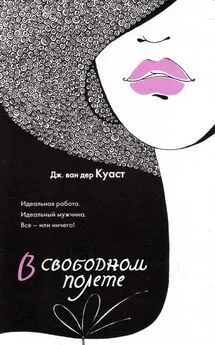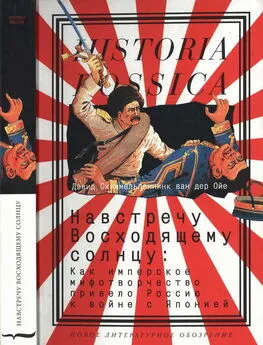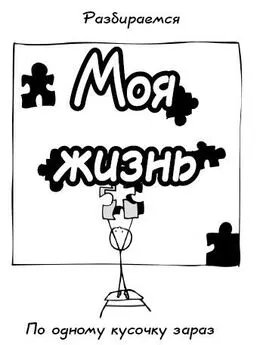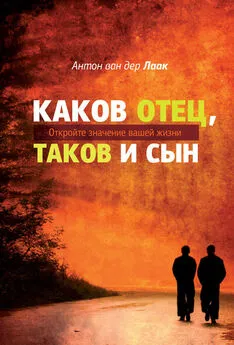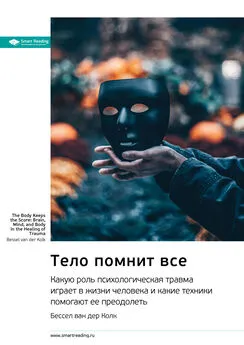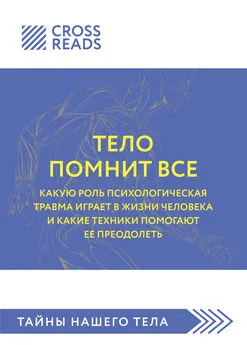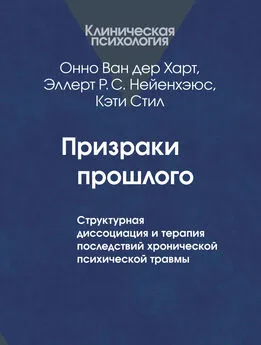Бессел ван дер Колк - Тело помнит все [Какую роль психологическая травма играет в жизни человека и какие техники помогают ее преодолеть]
- Название:Тело помнит все [Какую роль психологическая травма играет в жизни человека и какие техники помогают ее преодолеть]
- Автор:
- Жанр:
- Издательство:Литагент 5 редакция «БОМБОРА»
- Год:2019
- Город:Москва
- ISBN:978-5-04-099865-4
- Рейтинг:
- Избранное:Добавить в избранное
-
Отзывы:
-
Ваша оценка:
Бессел ван дер Колк - Тело помнит все [Какую роль психологическая травма играет в жизни человека и какие техники помогают ее преодолеть] краткое содержание
Доктор Бессел ван дер Колк, один из самых известных в мире специалистов по травме, провел более 30 лет, изучая посттравматическое стрессовое расстройство. Объединяя все исследования в области травмы, свой опыт и истории пациентов, в этой книге он объясняет, как травма буквально меняет тело и мозг, лишая переживших ее нормальной жизни, близких отношений и самоконтроля. Но есть и хорошие новости – автор расскажет, как мы можем помочь себе и своим близким в этой ситуации. Исследуя различные возможности исцеления: от медитации, йоги и спорта до занятий в театральных кружках – доктор Бессел предлагает новые пути к выздоровлению, активируя естественную нейропластичность мозга. Тем самым доктор дарит надежду на выздоровление и полноценную жизнь тем, кто столкнулся с травмой.
Внимание! Информация, содержащаяся в книге, не может служить заменой консультации врача. Перед совершением любых рекомендуемых действий необходимо проконсультироваться со специалистом.
Тело помнит все [Какую роль психологическая травма играет в жизни человека и какие техники помогают ее преодолеть] - читать онлайн бесплатно ознакомительный отрывок
Интервал:
Закладка:
13. B. A. van der Kolk, “Clinical Implications of Neuroscience Research in PTSD”, Annals of the New York Academy of Sciences 1071 (2006): 277–93.
14. P. D. MacLean, The Triune Brain in Evolution: Role in Paleocerebral Functions (New York, Springer, 1990).
15. Ute Lawrence, The Power of Trauma: Conquering Post Traumatic Stress Disorder , iUniverse, 2009.
16. Rita Carter and Christopher D. Frith, Mapping the Mind (Berkeley: University of California Press, 1998). См. также: A. Bechara, et al., “Insensitivity to Future Consequences Following Damage to Human Prefrontal Cortex”, Cognition 50, no. 1 (1994): 7–15; A. Pascual-Leone, et al., “The Role of the Dorsolateral Prefrontal Cortex in Implicit Procedural Learning”, Experimental Brain Research 107, no. 3 (1996): 479–85; and S. C. Rao, G. Rainer, and E. K. Miller, “Integration of What and Where in the Primate Prefrontal Cortex”, Science 276, no. 5313 (1997): 821–24.
17. H. S. Duggal, “New-Onset PTSD After Talamic Infarct”, American Journal of Psychiatry 159, no. 12 (2002): 2113-a. См. также: R. A. Lanius, et al., “Neural Correlates of Traumatic Memories in Posttraumatic Stress Disorder: A Functional MRI Investigation”, American Journal of Psychiatry 158, no. 11 (2001): 1920–22; and I. Liberzon, et al., “Alteration of Corticothalamic Perfusion Ratios During a PTSD Flashback”, Depression and Anxiety 4, no. 3 (1996): 146–50.
18. R. Noyes Jr. and R. Kletti, “Depersonalization in Response to Life-Threatening Danger”, Comprehensive Psychiatry 18, no. 4 (1977): 375–84. См. также: M. Sierra, and G. E. Berrios, “Depersonalization: Neurobiological Perspectives” , Biological Psychiatry 44, no. 9 (1998): 898–908.
19. D. Church, et al., “Single-Session Reduction of the Intensity of Traumatic Memories in Abused Adolescents After EFT: A Randomized Controlled Pilot Study”, Traumatology 18, no. 3 (2012): 73–79; and D. Feinstein and D. Church, “Modulating Gene Expression Trough Psychotherapy: The Contribution of Noninvasive Somatic Interventions”, Review of General Psychology 14, no. 4 (2010): 283–95. См. также: www.vetcases.com.
Глава 5. Связи между мозгом и телом
1. C. Darwin, The Expression of the Emotions in Man and Animals (London: Oxford University Press, 1998).
2. Там же, стр. 71.
3. Там же.
4. Там же, стр. 71–72.
5. P. Ekman, Facial Action Coding System: A Technique for the Measurement of Facial Movement (Palo Alto, CA: Consulting Psychologists Press, 1978). См. также: C.E. Izard, The Maximally Discriminative Facial Movement Coding System (MAX) (Newark, DE: University of Delaware Instructional Resource Center, 1979).
6. S. W. Porges, The Polyvagal Theory: Neurophysiological Foundations of Emotions, Attachment, Communication, and Self-Regulation , Norton Series on Interpersonal Neurobiology (New York: WW Norton & Company, 2011).
7. Так Стивен Поргес и Сью Картер называли вентральную ветвь блуждающего нерва. http://www.pesi.com/bookstore/A_Neural_Love_Code__The_Body_s_Need_to_Engage_ and_ Bond-details.aspx
8. S. S. Tomkins, Affect, Imagery, Consciousness (vol. 1, The Positive Affects) (New York: Springer, 1962); S. S. Tomkin, Affect, Imagery, Consciousness (vol. 2, The Negative Affects) (New York: Springer, 1963).
9. P. Ekman, Emotions Revealed: Recognizing Faces and Feelings to Improve Communication and Emotional Life (New York: Macmillan, 2007); P. Ekman, The Face of Man: Expressions of Universal Emotions in a New Guinea Village (New York: Garland STPM Press, 1980).
10. См., например, B. M. Levinson, “Human/ Companion Animal Therapy”, Journal of Contempora ry Psychotherapy 14, no. 2 (1984): 131–44; D. A. Willis, “Animal Therapy”, Rehabilitation Nursing 22, no. 2 (1997): 78–81; and A. H. Fine, ed., Handbook on Animal-Assisted Therapy: Theoretical Foundations and Guidelines for Practice (Waltham, MA: Academic Press, 2010).
11. P. Ekman, R. W. Levenson, and W. V. Friesen, “Autonomic Nervous System Activity Distinguishes Between Emotions”, Science 221 (1983): 1208–10.
12. J. H. Jackson, “Evolution and Dissolution of the Nervous System”, in Selected Writings of John Hughlings Jackson , ed. J. Taylor (London: Stapes Press, 1958), 45–118.
13. Про эту аналогию с зоомагазином мне рассказал Поргес.
14. S. W. Porges, J. A. Doussard-Roosevelt, and A. K. Maiti, “Vagal Tone and the Physiological Regulation of Emotion”, in The Development of Emotion Regulation: Biological and Behavioral Considerations , ed. N. A. Fox, Monographs of the Society for Research in Child Development , vol. 59 (2–3, serial no. 240) (1994), 167–86.
http://www.amazon.com/The-Development-Emotion-Regulation-Considerations/dp/0226259404
15. V. Felitti, et al., “Relationship of Childhood Abuse and Household Dysfunction to Many of the Leading Causes of Death in Adults: The Adverse Childhood Experiences (ACE) Study”, American Journal of Preventive Medicine 14, no. 4 (1998): 245–58.
16. S. W. Porges, “Orienting in a Defensive World: Mammalian Modifications of Our Evolutionary Heritage: A Polyvagal Theory”, Psychophysiology 32 (1995): 301–18.
17. B. A. Van der Kolk, “The Body Keeps the Score: Memory and the Evolving Psychobiology of Posttraumatic Stress”, Harvard Review of Psychiatry 1, no. 5 (1994): 253–65.
Глава 6. Теряя тело, теряя себя
1. K. L. Walsh, et al., “Resiliency Factors in the Relation Between Childhood Sexual Abuse and Adulthood Sexual Assault in College-Age Women”, Journal of Child Sexual Abuse 16, no. 1 (2007): 1–17.
2. A. C. McFarlane, “The Long-Term Costs of Traumatic Stress: Intertwined Physical and Psychological Consequences”, World Psychiatry 9, no. 1 (2010): 3–10.
3. W. James, “What Is an Emotion?” Mind 9: 188–205.
4. R. L. Bluhm, et al., “Alterations in Default Network Connectivity in Posttraumatic Stress Disorder Related to Early-Life Trauma”, Journal of Psychiatry & Neuroscience 34, no. 3 (2009): 187. См. также: J. K. Daniels, et al., “Switching Between Executive and Default Mode Networks in Posttraumatic Stress Disorder: Alterations in Functional Connectivity”, Journal of Psychiatry & Neuroscience 35, no. 4 (2010): 258.
5. A. Damasio , The Feeling of What Happens: Body and Emotion in the Making of Consciousness (New York: Hartcourt Brace, 1999). Damasio actually says, “Consciousness was invented so that we could know life”, с. 31.
6. A. Damasio, Feeling of What Happens , стр. 28.
7. Там же, стр. 29.
8. A. Damasio, Self Comes to Mind: Constructing the Conscious Brain (New York: Random House Digital, 2012), 17.
9. Damasio, Feeling of What Happens , стр. 256.
10. Antonio R. Damasio, et al., “Subcortical and Cortical Brain Activity During the Feeling of Self-Generated Emotions”. Nature Neuroscience 3, vol. 10 (2000):1049–56.
11. A. A. T. S. Reinders, et al., “One Brain, Two Selves”, NeuroImage 20 (2003): 2119–25. См. также: E. R. S. Nijenhuis, O. Van der Hart, and K. Steele, “The Emerging Psychobiology of Trauma-Related Dissociation and Dissociative Disorders”, in Biological Psychiatry , vol. 2., eds. H. A. H. D’Haenen, J. A. den Boer, and P. Willner (West Sussex, UK: Wiley 2002), 1079–198; J. Parvizi and A. R. Damasio, “Consciousness and the Brain Stem”, Cognition 79 (2001): 135–59; F. W. Putnam, “Dissociation and Disturbances of Self”, in Dysfunctions of the Self , vol. 5, eds. D. Cicchetti and S. L. Toth (Rochester, NY: University of Rochester Press, 1994), 251–65; and F. W. Putnam, Dissociation in Children and Adolescents: A Developmental Perspective (New York: Guilford, 1997).
12. A. D’Argembeau, et al., “Distinct Regions of the Medial Prefrontal Cortex Are Associated with Self-Referential Processing and Perspective Taking”, Journal of Cognitive Neuroscience 19, no. 6 (2007): 935–44. См. также: N. A. Farb, et al., “Attending to the Present: Mindfulness Meditation Reveals Distinct Neural Modes of Self-Reference”, Social Cognitive and Affective Neuroscience 2, no. 4 (2007): 313–22; and B. K. Hölzel, et al., “Investigation of Mindfulness Meditation Practitioners with Voxel-Based Morphometry”, Social Cognitive and Affective Neuroscience 3, no. 1 (2008): 55–61.
13. P. A. Levine, Healing Trauma: A Pioneering Program for Restoring the Wisdom of Your Body (Berkeley, CA: North Atlantic Books, 2008); and P. A. Levine, In an Unspoken Voice: How the Body Releases Trauma and Restores Goodness (Berkeley, CA: North Atlantic Books, 2010).
14. P. Ogden and K. Minton, “Sensorimotor Psychotherapy: One Method for Processing Traumatic Memory”, Traumatology 6, no. 3 (2000): 149–73; and P. Ogden, K. Minton, and C. Pain, Trauma and the Body: A Sensorimotor Approach to Psychotherapy, Norton Series on Interpersonal Neurobiology (New York: WW Norton & Company, 2006).
15. D. A. Bakal, Minding the Body: Clinical Uses of Somatic Awareness (New York: Guilford Press, 2001).
16. На эту тему было проведено огромное количество исследований. Вот лишь несколько примеров: J. Wolfe, et al., “Posttraumatic Stress Disorder and War-Zone Exposure as Correlates of Perceived Health in Female Vietnam War Veterans”, Journal of Consulting and Clinical Psychology 62, no. 6 (1994): 1235–40; L. A. Zoellner, M. L. Goodwin, and E. B. Foa, “PTSD Severity and Health Perceptions in Female Victims of Sexual Assault”, Journal of Traumatic Stress 13, no. 4 (2000): 635–49; E. M. Sledjeski, B. Speisman, and L. C. Dierker, “Does Number of Lifetime Traumas Explain the Relationship Between PTSD and Chronic Medical Conditions? Answers from the National Comorbidity Survey-Replication (NCS-R)”, Journal of Behavioral Medicine 31 (2008): 341–49; J. A. Boscarino, “Posttraumatic Stress Disorder and Physical Illness: Results from Clinical and Epidemiologic Studies”, Annals of the New York Academy of Sciences 1032 (2004): 141–53; M. Cloitre, et al., “Posttraumatic Stress Disorder and Extent of Trauma Exposure as Correlates of Medical Problems and Perceived Health Among Women with Childhood Abuse”, Women & Health 34, no. 3 (2001): 1–17; D. Lauterbach, R. Vora, and M. Rakow, “The Relationship Between Posttraumatic Stress Disorder and Self-Reported Health Problems”, Psychosomatic Medicine 67, no. 6 (2005): 939–47; B. S. McEwen, “Protective and Damaging Effects of Stress Mediators”, New England Journal of Medicine 338, no. 3 (1998): 171–79; P. P. Schnurr and B. L. Green, Trauma and Health: Physical Health Consequences of Exposure to Extreme Stress (Washington, DC: American Psychological Association, 2004).
17. P. K. Trickett, J. G. Noll, and F. W. Putnam, “The Impact of Sexual Abuse on Female Development: Lessons from a Multigenerational, Longitudinal Research Study”, Development and Psychopathology 23, no. 2 (2011): 453.
Читать дальшеИнтервал:
Закладка:
![Обложка книги Бессел ван дер Колк - Тело помнит все [Какую роль психологическая травма играет в жизни человека и какие техники помогают ее преодолеть]](/books/1065979/bessel-van-der-kolk-telo-pomnit-vse-kakuyu-rol-ps.webp)

